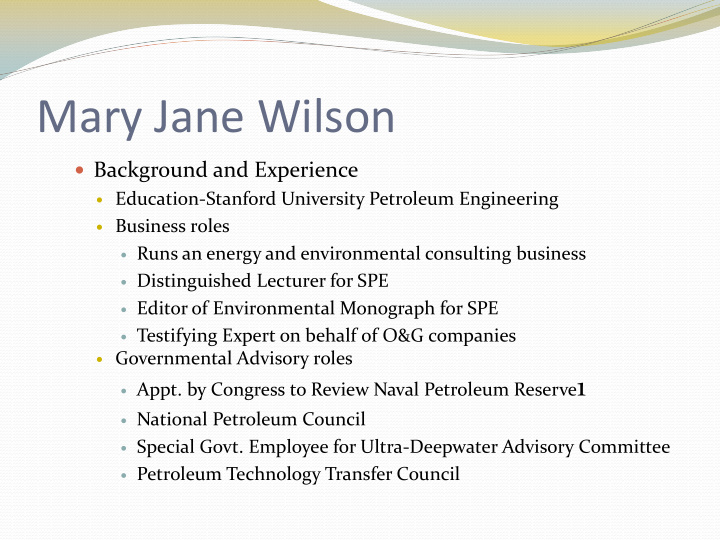



Mary Jane Wilson Background and Experience Education-Stanford University Petroleum Engineering Business roles Runs an energy and environmental consulting business Distinguished Lecturer for SPE Editor of Environmental Monograph for SPE Testifying Expert on behalf of O&G companies Governmental Advisory roles Appt. by Congress to Review Naval Petroleum Reserve 1 National Petroleum Council Special Govt. Employee for Ultra-Deepwater Advisory Committee Petroleum Technology Transfer Council
2014 Rulemaking for Oil and Gas WZI participated as a technical expert in this rule making at the request of EDF Summary of Key Findings: CDPHE used accepted methodology: In establishing the emission inventory In assigning emissions reductions for proposed alternatives In calculating the cost-effectiveness of program alternatives CDPHE cost estimates are reasonable and show program will be cost effective in reducing VOC and methane
LDAR Historically, LDAR has been in place in numerous facilities and air basins in various forms since the 80’s LDAR interfaces well with Planned Maintenance cycles which are focused on anticipating equipment failure and proactive maintenance LDAR programs in various forms have proven cost effective in reducing emissions Our opinion is that LDAR contributes to overall improvement of facility operations
CDPHE Proposed LDAR Tier-based approach results in sliding costs with lowest emitters bearing the least cost The CDPHE proposed reporting framework has a relatively minimal paperwork burden as compared to other LDAR programs The proposed LDAR program balances diminishing returns on emission reductions with industry costs
Louis Berger Group Program Economic Analysis: Key flaws Inflated Costs for: LDAR STEM Flares Incorrect Methodology for cost effectiveness
Inflated Costs LDAR LDAR equipment maintenance and training Component Repair (10 times expected values) Repaired Component Re-inspection (twice as high as complete facility inspections- done 12 times per year ) Findings are contrary to Economy-of-Scale expectations
Comparative Example- Repairs: 1784
Buffer Bottles as control devices Buffer Bottle Separator
Inflated Costs STEM Buffer Bottle Capital Costs and Maintenance Costs are overstated Similar errors as shown in prior LDAR discussion Flares Inflated Costs Useful life is understated Overstated Maintenance Costs STEM and Flares are still cost effective regardless of overstatement of costs
Incorrect Methodology Berger developed a sliding emissions inventory year- to-year EPA cites the use of a fixed datum (baseline) Baseline is established as a pre-rule inventory condition Program effectiveness is tied to the pre-rule minus post- rule emissions inventories Incremental reductions year-to-year simply underscore the degree of progress (trajectory) toward the final program control effectiveness Berger costs are skewed by levelized NPV calculations
Best Management Practices Best Management Practices for well maintenance such as swabbing and liquids unloading has been and will continue to be a general oil and gas industry practice. Examples: When swabbing in a well, use temporary or permanent equipment to Capture gas and send to gas treatment system or reinject Flare gas to permanent or temporary flare Limit unloading frequency and duration Install lift equipment or automatic controls that reduces or eliminates the need for unloading Correct problems with well completion and infrastructure
Conclusion CDPHE proposal is practical and applies common sense and reasonable approaches to control emissions from oil and gas operations Program is carefully tailored so that sites with fewer emissions have fewer requirements Program is cost effective Program will achieve large reductions in emissions
Recommend
More recommend